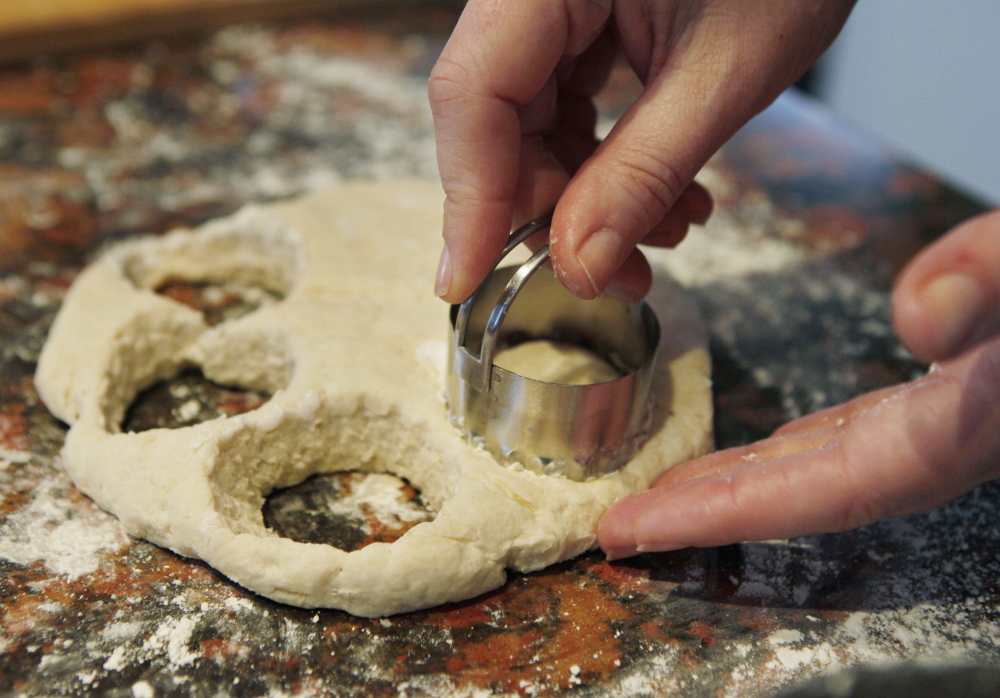I once managed a farmers market in Carlisle, Pennsylvania. As an outreach mechanism, I taught a class to children called “No-Thank-You Bites.” On a picnic blanket I laid out ordinary foods (peaches and carrots) and extraordinary ones (lovage and green zebra tomatoes). I asked the kids to agree to take one bite of any food before declaring it distasteful.
To keep small hands busy during class, I passed around mason jars of heavy cream to be shaken, one into whipped cream for berry dipping; the other into butter for local crackers and buttermilk for sipping. A cup of heavy cream, agitated long enough, generally yields a 1:1 ratio of butter to buttermilk.
Brilliant, one mom declared. This process would allow her to make a batch of biscuits (like the recipe below) without buying buttermilk and wasting what she didn’t use. Buttermilk can elevate the flavor of chocolate cake and the rise of pancakes; tenderize chicken in a marinade; and provide low-fat creaminess to salad dressings or tang to mashed potatoes. But I knew exactly what she meant. I, too, had neglected nearly full quarts of buttermilk until they went off.
There are three types of buttermilk, explains Alicia Mennard, a co-owner of Casco Bay Butter. The kind produced in my class, from straight cream, is called sweet cream buttermilk. If you add a yogurt culture to the cream before churning it, you get both cultured butter and cultured buttermilk, which is tangier than sweet cream buttermilk. (Kate’s Creamery in Arundel sells cultured buttermilk in Maine, Massachusetts and elsewhere in the Northeast.)
Early in Casco Bay Butter’s operation, all of its buttermilk went to a local pig farmer for slop. Now it sells both sweet cream and cultured buttermilk to restaurants like the Holy Donut in Portland and Biscuits & Company in Biddeford.
The third type, also called “cultured,” the kind most widely available in stores, is made by heating low-fat milk with active bacterial cultures to sour and thicken it.
You can simulate buttermilk, in a pinch, by mixing a tablespoon of white vinegar or lemon juice with a cup of low-fat or whole milk. “The chemistry works, but you can still taste that sharp acidic edge of the lemon juice or vinegar in the biscuit or scone,” Biscuit & Company owner Stacy Cooper said. It’s always a tastier bet to use real buttermilk, she argues, and to take steps to use it before you lose it.
Double Fluffy Buttermilk Biscuits
This recipe is adapted from one in “Southern Biscuits” by Nathalie Dupree and Cynthia Graubert. Biscuits & Company owner Stacy Cooper explains the tricks to ultra-fluffy biscuits are first, to use very cold ingredients and second, to retain the dough’s shaggy texture as you fold it into layers before baking. I tested these with King Arthur’s self-rising flour; to make a facsimile of self-rising flour, Dupree says to combine ½ cup all-purpose flour with ½ cup cake flour, ½ teaspoon salt and 1½ teaspoons baking powder.
Makes 14 (2½-inch) biscuits
2 to 2 1/4 cups self-rising flour
3/4 cup chilled vegetable shortening (or butter, lard or a mixture)
1 to 1 1/4 cups chilled buttermilk
Melted butter, for brushing
Preheat the oven to 400 degrees F. Brush a large baking sheet with melted butter.
Whisk 2 cups of the flour in a large bowl.
Cut 1/2 cup of the shortening into 1/4-inch pieces; cut the remaining 1/4 cup into 1/2-inch pieces. Scatter the 1/4-inch-size shortening pieces over the flour and work in by rubbing your fingers with the fat and flour until the mixture looks like well-crumbled feta cheese. Scatter the 1/2-inch-size pieces of chilled fat over the flour mixture and continue snapping thumb and fingers together until no pieces remain larger than a pea. If this method took longer than 5 minutes, place the bowl in the refrigerator for 5 minutes to rechill the fat.
Make a deep hollow in the center of the flour-fat mixture. Pour 1 cup of the buttermilk into the hollow, and mix just until the flour-fat mixture is moistened and the sticky dough begins to pull away from the sides of the bowl. If some flour remains on the bottom, stir in 1 to 4 tablespoons of additional buttermilk, just enough to incorporate the remaining flour into a shaggy dough. If the dough is too wet, use more flour when shaping.
Lightly sprinkle a clean surface with flour. Turn the dough out onto it and sprinkle the top lightly with flour. With floured hands, fold the dough in half, and pat out into a 1/3- to 1/2-inch thick round. Fold the dough in half a second time. If the dough is still clumpy, pat and fold a third time. Pat dough out into a 1/2- to 3/4-inch thick round. Brush off any visible flour from the top.
Dip a 21/2-inch biscuit cutter into flour and cut out biscuits 1 at a time, starting at the outside edge and cutting very close together, being careful not to twist the cutter. The scraps may be combined to make additional biscuits, although they will not be as tender.
Move the biscuits to the prepared baking sheet. Bake the biscuits on the top rack of the oven for 10 to 14 minutes until they are light golden brown, rotating about halfway through baking time. Remove from the oven and lightly brush the tops with butter. Turn the biscuits out upside down on a plate to cool slightly. Serve hot, right side up.
Christine Burns Rudalevige is a food writer, recipe developer and tester, and cooking teacher in Brunswick. Contact her at cburns1227@gmail.com.
Send questions/comments to the editors.



